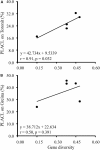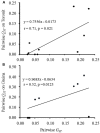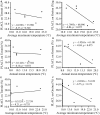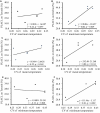Host Resistance and Temperature-Dependent Evolution of Aggressiveness in the Plant Pathogen Zymoseptoria tritici
- PMID: 28702023
- PMCID: PMC5487519
- DOI: 10.3389/fmicb.2017.01217
Host Resistance and Temperature-Dependent Evolution of Aggressiveness in the Plant Pathogen Zymoseptoria tritici
Abstract
Understanding how habitat heterogeneity may affect the evolution of plant pathogens is essential to effectively predict new epidemiological landscapes and manage genetic diversity under changing global climatic conditions. In this study, we explore the effects of habitat heterogeneity, as determined by variation in host resistance and local temperature, on the evolution of Zymoseptoria tritici by comparing the aggressiveness development of five Z. tritici populations originated from different parts of the world on two wheat cultivars varying in resistance to the pathogen. Our results show that host resistance plays an important role in the evolution of Z. tritici. The pathogen was under weak, constraining selection on a host with quantitative resistance but under a stronger, directional selection on a susceptible host. This difference is consistent with theoretical expectations that suggest that quantitative resistance may slow down the evolution of pathogens and therefore be more durable. Our results also show that local temperature interacts with host resistance in influencing the evolution of the pathogen. When infecting a susceptible host, aggressiveness development of Z. tritici was negatively correlated to temperatures of the original collection sites, suggesting a trade-off between the pathogen's abilities of adapting to higher temperature and causing disease and global warming may have a negative effect on the evolution of pathogens. The finding that no such relationship was detected when the pathogen infected the partially resistant cultivars indicates the evolution of pathogens in quantitatively resistant hosts is less influenced by environments than in susceptible hosts.
Keywords: Septoria tritici; evolution of plant pathogen; host resistance; natural selection; temperature-dependent; trade-offs.
Figures




Similar articles
-
Quantification of In Planta Zymoseptoria tritici Progression Through Different Infection Phases and Related Association with Components of Aggressiveness.Phytopathology. 2020 Jun;110(6):1208-1215. doi: 10.1094/PHYTO-09-19-0339-R. Epub 2020 Apr 22. Phytopathology. 2020. PMID: 32133920
-
Rapid Parallel Evolution of Azole Fungicide Resistance in Australian Populations of the Wheat Pathogen Zymoseptoria tritici.Appl Environ Microbiol. 2019 Feb 6;85(4):e01908-18. doi: 10.1128/AEM.01908-18. Print 2019 Feb 15. Appl Environ Microbiol. 2019. PMID: 30530713 Free PMC article.
-
Ranking Quantitative Resistance to Septoria tritici Blotch in Elite Wheat Cultivars Using Automated Image Analysis.Phytopathology. 2018 May;108(5):568-581. doi: 10.1094/PHYTO-04-17-0163-R. Epub 2018 Apr 4. Phytopathology. 2018. PMID: 29210601
-
Dissecting the Molecular Interactions between Wheat and the Fungal Pathogen Zymoseptoria tritici.Front Plant Sci. 2016 Apr 15;7:508. doi: 10.3389/fpls.2016.00508. eCollection 2016. Front Plant Sci. 2016. PMID: 27148331 Free PMC article. Review.
-
How Knowledge of Pathogen Population Biology Informs Management of Septoria Tritici Blotch.Phytopathology. 2016 Sep;106(9):948-55. doi: 10.1094/PHYTO-03-16-0131-RVW. Epub 2016 Jul 27. Phytopathology. 2016. PMID: 27111799 Review.
Cited by
-
Tackling microbial threats in agriculture with integrative imaging and computational approaches.Comput Struct Biotechnol J. 2020 Dec 29;19:372-383. doi: 10.1016/j.csbj.2020.12.018. eCollection 2021. Comput Struct Biotechnol J. 2020. PMID: 33489007 Free PMC article. Review.
-
In Vitro and In Planta Studies on Temperature Adaptation of Exserohilum turcicum Isolates from Maize in Europe and South America.Pathogens. 2021 Feb 2;10(2):154. doi: 10.3390/pathogens10020154. Pathogens. 2021. PMID: 33540950 Free PMC article.
-
Mechanistic models to meet the challenge of climate change in plant-pathogen systems.Philos Trans R Soc Lond B Biol Sci. 2023 Mar 27;378(1873):20220017. doi: 10.1098/rstb.2022.0017. Epub 2023 Feb 6. Philos Trans R Soc Lond B Biol Sci. 2023. PMID: 36744564 Free PMC article. Review.
-
Increasing temperature elevates the variation and spatial differentiation of pesticide tolerance in a plant pathogen.Evol Appl. 2021 Feb 2;14(5):1274-1285. doi: 10.1111/eva.13197. eCollection 2021 May. Evol Appl. 2021. PMID: 34025767 Free PMC article.
-
Climate change and disease in plant communities.PLoS Biol. 2020 Nov 24;18(11):e3000949. doi: 10.1371/journal.pbio.3000949. eCollection 2020 Nov. PLoS Biol. 2020. PMID: 33232314 Free PMC article.
References
-
- Ahmed H. U., Mundt C. C., Coakley S. M. (1995). Host-pathogen relationship of geographically diverse isolates of Septoria tritici and wheat cultivars. Plant Pathol. 44 838–847. 10.1111/j.1365-3059.1995.tb02743.x - DOI
-
- Ahmed H. U., Mundt C. C., Hoffer M. E., Coakley S. M. (1996). Selective influence of wheat cultivars on pathogenicity of Mycosphaerella graminicola (Anamorph Septoria tritici). Phytopathology 86 454–458. 10.1094/Phyto-86-454 - DOI
-
- Altizer S., Harvell D., Friedle E. (2003). Rapid evolutionary dynamics and disease threats to biodiversity. Trends Ecol. Evol. 18 589–596. 10.1016/j.tree.2003.08.013 - DOI
LinkOut - more resources
Full Text Sources
Other Literature Sources

